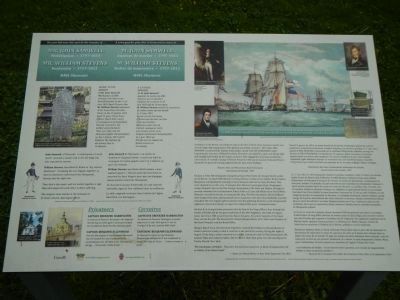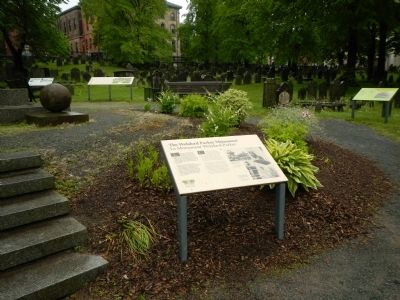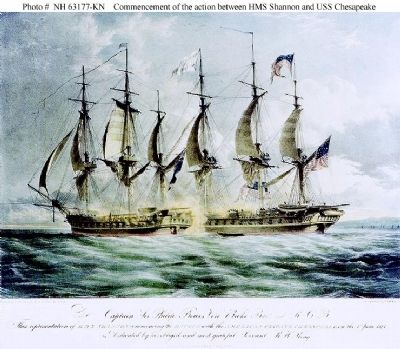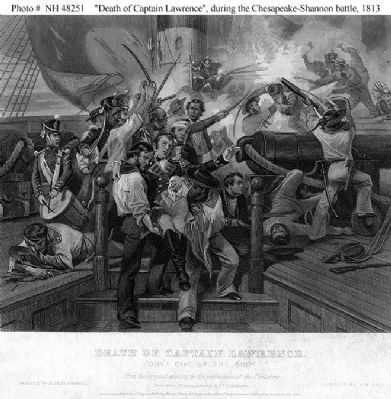Halifax in Halifax Region, Nova Scotia — The Atlantic Provinces (North America)
Mr. John Samwell
Mr. William Stevens

Photographed By Barry Swackhamer, June 14, 2014
1. Mr. John Samwell Marker
Captions: (left side) Replica stone in Old Burying Ground (circa 1860?) / Réplique de la stèle au Vieux cimetière (vers 1860?); St. Paul’s Church, 2012 / L’église Saint Paul, 2012; St. Paul’s Church, 1813 / L’église Saint Paul, 1813; (top right) HMS Shannon leads USS Chesapeake up harbour Halifax, Nova Scotia, June 6, 1813 / Le HMS Shannon escorte USS Chesapeake dans le port d’Halifax, Nouvelle-Écosse, le 6 juin 1813; (small pictures clockwise from the top left) Captain/Capitaine Philip Broke; Captain/ Capitaine James Lawrence, USS Chesapeake; The Lawrence Tomb, Trinity Church, New York / La tombe de Lawrence, Élise de Trinity, New York; Lieutenant Provo Wallis, Royal Navy / Marine royale.
Midshipman / Aspirant de marine • 1797-1813
Mr. / M. William Stevens
Boatswain / Maître de manoeuvre • 1757-1813
HMS Shannon
Of Mr John Samwell Midshipman of HMS Shannon who red at the nav(e)l hospital on the 13 of June 1813 aged 18 years Also Mr William Stevens boatswain of the Same Ship who died there on the 19 of June 1813 aged 56 years Those brave officiers Clos’d their career in consequence of desperat(e) wounds received in the gallant action between their own Ship and the American frigate Chesepe(a)k(e) on the 1 of June 1813 which ended in the Capture of the Enemy Ship in 14 Minutes.
De M. John Samwell aspirant de marine du HMS Shannon qui est décédé à l’hôpital de la marine le 13 juin 1813 âgé de 18 ans Aussi M. William Stevens maître de manoeuvre du même navire qui est décédé le 19 juin 1813 âgé du 56 ans Ces braves officiers ont clos leur carrière suite aux terribles blessures subies lors de l’action courageuse entre leur propre navire et la frégate américaine Chesepe(a)k(e) le 1 juin 1813 qui prit fin avec la capture du navire ennemi en 14 minutes.
English / French
John Samwell, of Plymouth, “a midshipman of much merit”, received a musket ball in his left thigh, but was expected to recover. / John Samwell de Plymouth, «un maître de manoeuvre de grand mérite», reçoit une balle de mousquet à la cuisse gauche mais l’on s’attend à ce qu’il s’en remette.
William Stevens, described by Broke as “my veteran Boatswain”. In lashing the two frigates together so that his Shannons could board the Chesapeake, Stevens lost his right arm. / William Stevens, que Broke décrit comme «mon aspirant aguerri». Stevens perd son bras droit en amarrant les deux frégates pour que son équipage puisse monter à bord du Chesapeake.
They died a day apart, and are buried together, a sign they had supported each other in their suffering. / Ils meurent à un jour d’intervalle. Ils sont enterrés ensemble, signe de leur solidarité dans la souffrance.
The original stone stands in the entrance of St. Paul’s Church, Barrington Street. / La stèle originelle se trouve dans l’entrée de l’église Saint Paul, rue Barrington.
English / French
Captain / Capitaine
Ebenezer Harrington
In memory of Ebenezer Harrington who departed this life Aug. 12, 1812 aged 57 years of Liverpool. He was killed on board His Maj Schooner Chubb. / En mémoire de Ebenezer Harrington qui quitta cette vie le 12 août 1812 âgé de 57 ans de Liverpool. Il fut tué à bord du HMS Chubb.
Captain / Capitaine Benjamin Ellenwood
Here lies the remains of Capt. Benjamin Ellenwood late of Liverpool N.S. who was found cruelly murdered Jany 31st AD 1815 in the 32nd year of his age… he has left a widow and four… / Ice reposent les restes du Capt. Benjamin Ellenwood de Liverpool N.É. tué cruellement le 31 jan. 1815 âgé de 32 ans… il laisse sa veuve et quatre…
English
Confidence in the British navy faltered early in the War of 1812 when American vessels won several single-ship engagements. This pattern was broken on June 1, 1813 when HMS Shannon, commanded by Captain Philip Broke, closed with USS Chesapeake under Captain James Lawrence off Boston harbour. The latter was taken in a short and bloody fight and brought into Halifax by her captor on June 6. This engagement was long considered a naval classic. In marked a change in British fortunes in war at sea and vindicated Broke’s insistance on gunnery training neglected by the navy since Trafalgar.
of Canada
Government of Canada - 1927
On June 1, 1813 USS Chesapeake, flying the pennant FREE TRADE AND SAILORS RIGHTS, sailed out of Boston to attack HMS Shannon waiting offshore. Certain of yet another British defeat, Bostonians anticipating the evening’s victory banquet came out to enjoy the show. They were shocked to see that only 15 minutes after Shannon’s great guns fired, Chesapeake’s ensign dropped! Up rose the Blue Ensign, flying below it the Stars and Stripes. His captain severely wounded, the first lieutenant killed, it fell to 22 year old Halifax born Provo Wallis, Shannon’s second lieutenant, to command the ship. The third lieutenant, Charles Falkiner, took charge of the prize, giving special care to Lawrence, who lay in his wardroom, mortally wounded. The two frigates sailed eastward into the gathering darkness as the disappointed sightseers returned to Boston to report the unbelievable new: Chesapeake taken.
On June 8, in a long solemn procession first by boat to the King’s Wharf, then through the streets of Halifax led by the guard and band of the 64th Regiment, the body of Captain James Lawrence, USN moved from his ship to his grave. Six senior Captains of the Royal Navy carried his pall. The Reverend Dr. Robert Stanser, Rector of St. Paul’s and Chaplain to the Navy Hospital read the Burial Office.
Flying a flag of truce, the American brig Henry entered the harbour to ask permission to return Lawrence’s body so that it could lie in the soil of his country. During the night of August 19 the brig’s sailors removed two coffins. Lawrence’s and his First Lieutenant’s, Mr. Ludlow. They were taken to Salem, MA for burial. Their final grave is in the churchyard of Trinity Church, New York.
”The Inhabitants of Halifax - They have honoured our Lawrence. In deeds of magnanimity let us initiate, if we cannot excel!” - Toast at a Naval Dinner in New York, September 24, 1814.
French
Durant la guerre de 1812, on douta bientôt de la marine britannique quand des navires américains remportèrent plusieurs combats singuliers. La situation changea le 1er juin 1813 quand le HMS Shannon, commandé par le capitaine Philip Broke, affronta au large de Boston, le USS Chesapeake, commandé par le capitaine James Lawrence. Ce dernier, capturé après une brève lutte sanglante, fut amené à Halifax le 6 juin. Cette bataille longtemps jugée classique, marqua un revirement du sort des Britanniques et justifia l’importance que Broke accordait aux exercices de tir au canon négligés depuis Trafalgar.
Government du Canada - 1927
Le 1er juin 1813, le USS Chesapeake, battant le pavillon COMMERCE LIBRE ET DROITS DES MARINS, quitte le port de Boston afin d’affronter le HMS Shannon. Confiants d’une autre défaite britannique et anticipant le banquet de victoire en soirée, les Bostonnais s’embarquent en mer pour assister a la bataille. Ils sont étonnée de voir le pavillon du Chesapeake s’ abaisser à peine quinze minutes après les coups de canon du Shannon. Le pavillon blue est hissé avec la bannière étoilée en-dessous. Puique son capitaine est grièvement blessé et son premier lieutenant tue, Provo Wallis, le jeune deuxième lieutenant de 22 ans et natif d’Halifax, se voit oblige de prendre la commande du Shannon. Le troisième lieutenant, Charles Falkiner prend charge de la prise, administrant des soins attentifs à Lawrence, étendu mortellement blessé dans la carré des officiers. Les deux frégates partent vers l’est, s’enfonçant dans la nuit tombante, alors que les spectateurs déçus rentrent à Boston avec la nouvelle incroyable : le Chesapeake capturé.
Le 8 juin, le corps du Capitaine James Lawrence USN est porté de son navre à sa tombe d’abord dans un long défilé solennel en bateau jusqu’au Quai Kings, puis escorté à travers les rues d’Halifax par la garde et la fanfare du 64ᵉ Régiment. Six capitaines supérieurs de la Marine royale agissent comme porteurs. Le Révérend Dr. Robert Stanser, recteur de Saint-Paul et aumônier à l’Hôpital de la Marine, préside le service funéraire.
Battant un drapeau blanc, le brick américain Henry entre dans le port afin de demander la permission de reprendre le corps de Lawrence de sorte qu’il puisse être inhumé dans sa partie. Au cours de la nuit du 19 août, les marins du brick déplacent deux cercueils, celui de Lawrence et celui de son premier lieutenant, Mr. Ludlow. Ils sont transportés à Salem, Mass., pour l’inhumation. Ils son enterrés au cimetière de l’église Trinity, New York.
«Les habitants de Halifax - Ils ont honoré notre Lawrence lors d’actes de magnanimité imitons si nous ne pouvons exceller! -Toast porté à l’occasion d’un dîner de la marine à New York, le 24 septembre 1814.
Erected by Old Burying Ground Foundation.
Topics. This historical marker is listed in these topic lists: Cemeteries & Burial Sites • War of 1812 • Waterways & Vessels. A significant historical date for this entry is June 13, 1813.
Location. 44° 38.61′ N, 63° 34.352′ W. Marker is in Halifax, Nova Scotia, in Halifax Region. Marker can be reached from Barrington Street close to Spring Garden Road, on the left when traveling south. This marker is located near the Welsford Parker Monument. Touch for map. Marker is at or near this postal address: 1480 Barrington Street, Halifax NS B3J, Canada. Touch for directions.
Other nearby markers. At least 8 other markers are within walking distance of this marker. The Welsford Parker Monument (here, next to this marker); The Old Burying Ground (a few steps from this marker); Carved in Stone (a few steps from this marker); a different marker also named Old Burying Ground (a few steps from this marker); a different marker also named Old Burying Ground (a few steps from this marker); Why Aren’t We Americans? • Pourquoi ne sommes-nous pas des Américains? (a few steps from this marker); Major General / Major-Général Robert Ross 1766-1814 (within shouting distance of this marker); St. Mary’s Basilica (about 90 meters away, measured in a direct line). Touch for a list and map of all markers in Halifax.
Also see . . . Capture of USS Chesapeake. The engagement had lasted just ten minutes according to Shannon's log, or eleven minutes by Lieutenant Wallis' watch. Broke more modestly claimed fifteen minutes in his official despatch. Shannon had lost 23 men killed, and had 56 wounded. Chesapeake had about 48 killed, including four lieutenants, the master and many other of her officers, and 99 wounded. Shannon had been hit by a total of 158 projectiles, Chesapeake by 362. In the time the batteries of both ships were firing, the Americans had been exposed to 44 roundshot, whilst the British had received 10 or 11 in reply (these are figures for shot which would have produced casualties or material damage; some of the Chesapeake's shot was fired low, bouncing off the Shannon's side at waterline level). Even before being boarded, Chesapeake had lost the gunnery duel by a considerable margin. (Submitted on October 9, 2014, by Barry Swackhamer of Brentwood, California.)
Credits. This page was last revised on June 16, 2016. It was originally submitted on October 9, 2014, by Barry Swackhamer of Brentwood, California. This page has been viewed 570 times since then and 12 times this year. Last updated on October 12, 2014, by Barry Swackhamer of Brentwood, California. Photos: 1. submitted on October 11, 2014, by Barry Swackhamer of Brentwood, California. 2, 3, 4. submitted on October 9, 2014, by Barry Swackhamer of Brentwood, California. • Andrew Ruppenstein was the editor who published this page.


